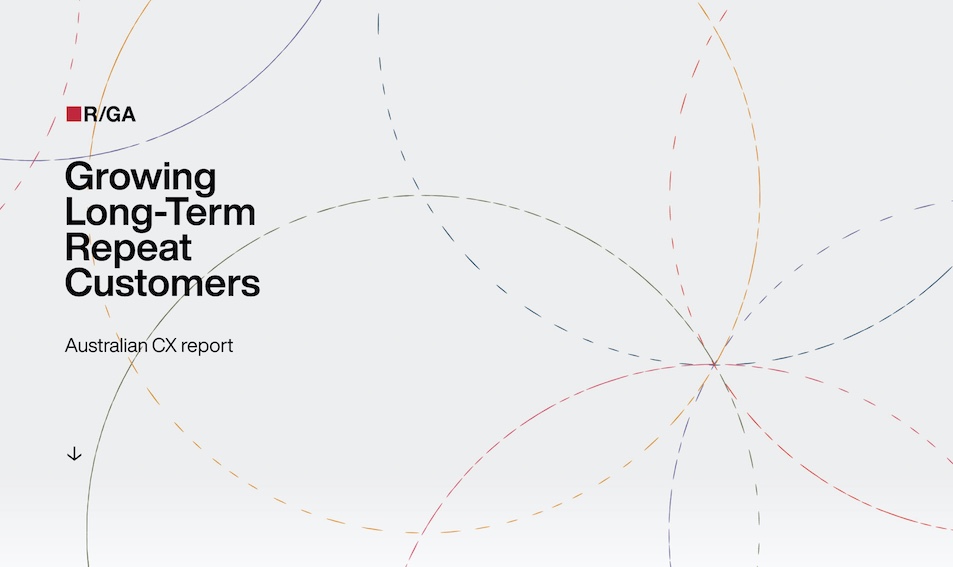Australia’s Loyalty Crisis: R/GA’s New Report Uncovers a Staggering 60% of Customers in Australia Unlikely to Return

R/GA Australia has released a CX report that reveals a loyalty crisis in Australia. Despite widespread recognition of digital services, a range of basic, psychological and human needs are failing to be met. When compared with other Asia Pacific countries surveyed in the report, customers in Australia place “product and service curation” as their last priority, emphasizing post-purchase help and communication as more important. Like never before, there are new expectations and dynamics required for people in Australia to stay bought into services.
The research surveyed nearly 16,000 people in the US, EMEA, LATAM, and APAC across 15 service verticals, and in Australia honed in on seven: automotive, banking, insurance (general, health & life), retail, superannuation, telco and utilities.
Over half of the respondents surveyed (52%) experienced disappointment in their first time using a service or product
More than half of all Australian customers (52%), across all generations, are experiencing a disconnect between promises made by brands, and the actual reality. As a result, they feel brands oversell their product experiences. With so much emphasis placed on experience, disappointing a new customer can have colossal consequences. For example, dropping the ball after a successful (and exorbitantly expensive) customer acquisition can result in years of lost subscription revenue, usage, and additional purchases.
Traditional loyalty programmes are failing
In Australia, there is a gap between the promise of loyalty programmes and its commercial impact. 84% of Australians say loyalty programs are important, but only 12% sign up after the purchase. Loyalty describes customers who are committed to buying from the brand, regardless of what it offers. In Australia, most programs labelled “loyalty” are more accurately “frequency” programs. They only seek to prod the customer into becoming a repeat purchaser, running exclusively on that individual’s frequency data with no insight into a customer’s actual loyalty for that particular brand. This results in a superficial mode of loyalty that isn’t effectively inspiring anyone beyond the already loyal.
Australians are hungry for community, but only 23% of them consider themselves to be part of one
The study reveals potential confusion or complexity around the definition of a brand community. When Australians were asked whether they considered themselves to be a member, or part of a brand community after making a purchase: 23% said yes, 37% said no, 21% said somewhat and 20% said they weren’t aware there was a brand community to be a part of. These mixed results are compounded by the fact that the nature of the brand community is changing, from large social followings to brands nurturing smaller fan networks to build deep community connections and more intimate services. While the exact definition of community and customer’s relationship with it remains muddy, the appetite for community-powered experiences is strong.
Implications for brands and businesses
While the global findings suggest significant progress is required to better meet these growing needs, there are variations across countries. In Australia, the only way to succeed long-term is for brands to build genuine relationships with Australians.
These findings carry significant implications for brands and businesses in terms of how they engage with customers and the report includes a series of recommendations:
– Amid a steady increase of disloyalty, brands need to shift their focus to helping people make the most of their purchases by building genuine relationships.
– With a disproportionate amount of money invested in post-purchase sales, businesses need to compete on the basics of post-purchase support. By focusing on proactive customer care, not sales, brands can also maximise the value of interactions, as consumers increasingly turn from customers into brand advocates.
– The desire for a more human future of loyalty has led to more Australians wanting to stay connected to a community. Brands must now undertake a bigger responsibility to bring communities together to meet people’s expansive needs of happiness, health and wellbeing.
Says Michael Titshall, VP and managing director, R/GA Australia: “It is clear there is a disconnect between what Australian expect from brands and what they are getting. The moments immediately after a purchase are critical for a strong relationship to be formed between customer and brand. But with a focus on getting the sale done, many brands are not delivering on their promise and therefore not fostering long-term repeat customers.
“We see an enormous opportunity to drive business growth through post-purchase innovation.”
Methodology and country rankings
From June 14 to September 27, 2020, R/GA surveyed nearly 16,000 consumers in the US, EMEA, LATAM, and APAC across 15 service verticals.
External interviews were also conducted with subject matter experts and industry stakeholders. The goal of this proprietary research was twofold: to understand how brand relationships are evolving across product/service verticals—and what it takes to create the most optimal post-purchase customer relationship.
Markets covered: Argentina, Australia, Brazil, China, Germany, Japan, Singapore, UK and the US.
